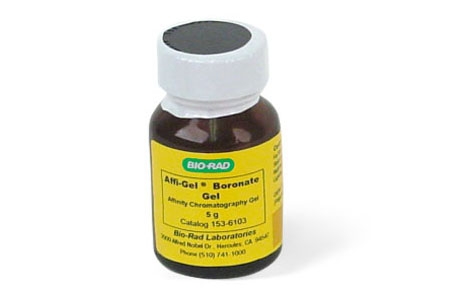
Description
Description
Affi-Gel boronate-derivatized polyacrylamide gel has affinity for coplanar adjacent cis-hydroxyl groups (cis-diols) and a high binding capacity, which provides highly efficient separation of low molecular weight molecules such as nucleotides, nucleosides, catecholamines, and sugars. It has a sorbitol capacity of 130 µmol/ml.
Key Features
- High boronate capacity — 1.05 ± 0.15 meq/g
- High diol capacity — binds 130 µmol sorbitol/ml gel
- Spherical polyacrylamide matrix — excellent flow rate, resolution, and reproducibility
- Low nonspecific absorption, optimum porosity — low exclusion limit precludes significant binding of high molecular weight molecules while allowing rapid equilibration and binding of low and medium molecular weight molecules
Preparation and Use
The gel is supplied as dried material and must be hydrated in an appropriate buffer. Buffer choice is dependent upon application. Buffers such as Tris should be avoided as they can adversely affect binding capacity (Schott et al.1973). The presence of Mg2+ may enhance binding. In general, binding is effected at pH > 7.5 and elution at pH < 6.5. boric acid, sorbitol, or mannitol can also be used for elution.
For more information, request Bulletin 1066, which can be found under the Documents tab.
Ordering
Ordering
items
Use the filters below to refine results!





